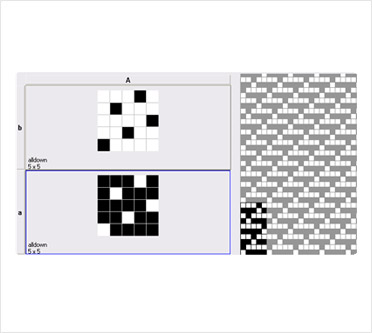

The weaver can change the sequence of lifts in the set of pegs in the lags, or in the computer file, and uses the single or pair of treadles to weave through a sequence of lifts. One or two treadles work the dobby system which replaces the set of multiple treadles. So it’s time to meet the dobby loom – a mechanical lifting device with either a system of lags (or bars) with pegs and holes, or a compudobby box attached to a computer which can do all the shaft selection for you. Most eight-shaft looms have only 10 to 14 treadles and it takes time to re-tie treadles to weave different combinations of lifts. The more treadles we have to use, the trickier it becomes to select the correct treadle and even remember the treadling sequence. An eight-shaft loom has 254 combinations of lifts.

Fig 4 Fig 3Īs more shafts bring flexibility in design, they also bring restrictions. We can thread a loom with eight shafts to be able to weave both honeycomb and twill (as in figures 3 and 4). However we cannot weave the twill shown in figure 2. If we thread a four-shaft loom with two different two-thread blocks (as in figure 1), we can weave all sorts of interesting textures, such as honeycomb.

The more shafts we add to our loom, the more complex the choices we can make in our weaving. If we want to weave all 14 combinations in one piece of fabric, it is easily done even on a counterbalanced treadle loom, although there is a reduced shed where three shafts work against one. Weaving on a four-shaft treadle loom, we set up the treadles thoughtfully to use all 14 combinations available. To gain a little extra speed we can replace the levers on a table loom with treadles and use our feet to raise the shafts, while our hands handle the weft yarn in the shuttle. The more shafts available, the more design options available to the weaver. The weaver uses levers to raise one or more shafts, which in turn raises the set of threads controlled by each shaft. All threads pass through a heddle on one shaft or another, and through one heddle only. Shaft looms generally have between four and sixteen shafts. Table looms have heddles arranged on frames called shafts, controlled by levers. (For more information on weave terminology and looms see the Weave Glossary, p. The principal distinguishing element between looms is how the weaver raises warp threads to make a shed through which to pass an interlacing weft to weave fabric. Weaving looms come in all shapes and sizes: tapestry frames and looms, inkle, rigid heddle looms, table and floor looms, dobby and Jacquard looms.


 0 kommentar(er)
0 kommentar(er)
